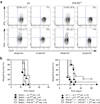Type I interferons are not critical for skin allograft rejection or the generation of donor-specific CD8+ memory T cells
- PMID: 19951284
- PMCID: PMC2806930
- DOI: 10.1111/j.1600-6143.2009.02871.x
Type I interferons are not critical for skin allograft rejection or the generation of donor-specific CD8+ memory T cells
Abstract
Type I interferons (IFN-I) link innate to adaptive immunity in microbial infection, autoimmune disease and tumor immunity. It is not known whether IFN-I have an equally central role in alloimmunity. Here we tested this possibility by studying skin allograft survival and donor-specific CD8+ T-cell responses in mice that lack the IFN-I receptor (IFN-IR-/-). We found that IFN-IR-/- mice reject fully allogeneic wild-type skin grafts at the same rate as wild-type recipients. Similarly, allograft rejection was not delayed if IFN-IR-/- male skin was transplanted to syngeneic IFN-IR-/- female mice. Quantitation of the male (H-Y)-specific CD8+ T-cell response in these mice revealed normal generation of donor-specific CD8+ effector T cells but fourfold reduction in CD8+ memory T cells. Memory CD8+ T cells generated in the absence of IFN-IR had normal phenotype and recall function, assessed by ex vivo cytokine production and the ability of IFN-IR-/- mice to mount second set rejection. Finally, these memory T cells were maintained at a constant number despite their inability to respond to IFN-1. Our findings indicate that IFN-I cytokines are not critical for acute allograft rejection or for the expansion and differentiation of donor-specific CD8+ T cells into long-lived, functional memory T cells.
Conflict of interest statement
The authors have no financial conflict of interest to disclose.
Figures



Similar articles
-
IFN-gamma dictates allograft fate via opposing effects on the graft and on recipient CD8 T cell responses.J Immunol. 2009 Jan 1;182(1):225-33. doi: 10.4049/jimmunol.182.1.225. J Immunol. 2009. PMID: 19109153 Free PMC article.
-
Alloreactive CD8 T-cell primed/memory responses and accelerated graft rejection in B-cell-deficient sensitized mice.Transplantation. 2011 May 27;91(10):1075-81. doi: 10.1097/TP.0b013e31821578da. Transplantation. 2011. PMID: 21427633 Free PMC article.
-
The roles of CD8 central and effector memory T-cell subsets in allograft rejection.Am J Transplant. 2008 Sep;8(9):1809-18. doi: 10.1111/j.1600-6143.2008.02335.x. Epub 2008 Jul 28. Am J Transplant. 2008. PMID: 18671680 Free PMC article.
-
CD8+ effector memory T cells induce acute rejection of allogeneic heart retransplants in mice possibly through activating expression of inflammatory cytokines.Exp Cell Res. 2017 Jun 1;355(1):1-8. doi: 10.1016/j.yexcr.2017.02.036. Epub 2017 Feb 21. Exp Cell Res. 2017. PMID: 28232114
-
Immunobiology of allograft rejection in the absence of IFN-gamma: CD8+ effector cells develop independently of CD4+ cells and CD40-CD40 ligand interactions.J Immunol. 2001 Mar 1;166(5):3248-55. doi: 10.4049/jimmunol.166.5.3248. J Immunol. 2001. PMID: 11207279
Cited by
-
Innate allorecognition in transplantation.J Heart Lung Transplant. 2021 Jul;40(7):557-561. doi: 10.1016/j.healun.2021.03.018. Epub 2021 Mar 29. J Heart Lung Transplant. 2021. PMID: 33958265 Free PMC article. Review.
-
The innate immune system in transplantation.Semin Immunol. 2011 Aug;23(4):264-72. doi: 10.1016/j.smim.2011.06.006. Epub 2011 Jul 1. Semin Immunol. 2011. PMID: 21723740 Free PMC article. Review.
-
Dendritic cells and innate immunity in kidney transplantation.Kidney Int. 2015 Apr;87(4):712-8. doi: 10.1038/ki.2014.430. Epub 2015 Jan 28. Kidney Int. 2015. PMID: 25629552 Free PMC article. Review.
-
Innate allorecognition.Immunol Rev. 2014 Mar;258(1):145-9. doi: 10.1111/imr.12153. Immunol Rev. 2014. PMID: 24517431 Free PMC article. Review.
-
T-cell activation and transplantation tolerance.Transplant Rev (Orlando). 2012 Jul;26(3):212-22. doi: 10.1016/j.trre.2011.09.002. Epub 2011 Nov 8. Transplant Rev (Orlando). 2012. PMID: 22074786 Free PMC article. Review.
References
-
- Theofilopoulos AN, Baccala R, Beutler B, Kono DH. Type I interferons (alpha/beta) in immunity and autoimmunity. Annu Rev Immunol. 2005;23:307–336. - PubMed
-
- Garcia-Sastre A, Biron CA. Type 1 interferons and the virus-host relationship: a lesson in detente. Science. 2006;312(5775):879–882. - PubMed
-
- Muller U, Steinhoff U, Reis LF, Hemmi S, Pavlovic J, Zinkernagel RM, et al. Functional role of type 1 and type II interferons in antiviral defense. Science. 1994;(264) - PubMed
Publication types
MeSH terms
Substances
Grants and funding
LinkOut - more resources
Full Text Sources
Molecular Biology Databases
Research Materials

